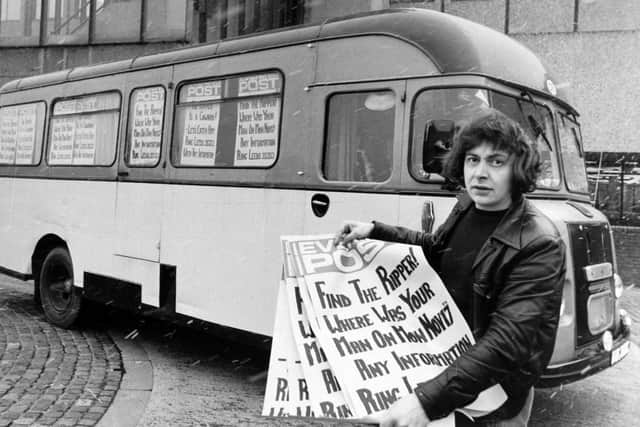Peter Sutcliffe meant our family lived in fear that one terrible night our cousin might never come home - Jayne Dowle
I would lie awake at night worrying for my cousin, who was 17 in 1975. She was our babysitter and seemed impossibly glamorous with her long dark swishy hair and flared trousers.
When she wasn’t looking after me and my sister on Saturday nights, she loved to go out with her friends to pubs, clubs and discotheques.
Advertisement
Hide AdAdvertisement
Hide AdLeeds in the 1970s was an entertainment mecca. And Leeds was where the first murders were happening. That much we knew, in our street in Barnsley, only 20 miles away.


No-one said anything, but as the years (and the deaths and attacks) went by, we recognised that our family lived in fear that one terrible night our cousin might never come home.
Unlike today, adults and children didn’t sit down and discuss their anxieties or what was happening in the news. Death, loss and any kind of sexual motivation were definitely off limits. We knew there was evil in the world, but no idea of how it might manifest itself.
We children inhabited a hinterland between the post-war childhoods of our parents, who were raised to be seen and not heard, and the world around us, full of social and political upheaval; strikes, power cuts, the three-day week, unemployment, feminism and yes, the man who would become known as ‘the Yorkshire Ripper’ lurking out there, somewhere.
Advertisement
Hide AdAdvertisement
Hide AdIt could often be a dark world, full of threats we couldn’t quite name. The memory of the Moors murders, although committed by Ian Brady and Myra Hindley a decade earlier, still outstretched its vile presence, talked over by the adults as a terrible stain on the North.
Every time we went to Blackpool across the M62 near Saddleworth, someone on the coach would mention the unmarked graves of Brady and Hindley’s young victims, still undiscovered in the mist.
We learned early on that children were vulnerable. And when the Yorkshire Ripper began to stalk so close to us in Leeds and Bradford, we learnt that women were too. Women and children, in our tight working-class world, were our most familiar touchstones. The biggest fear we had was ‘mammy’ running to the shop and disappearing.
My husband, whose mother worked as a postwoman in the mid-1970s, says that every time she left for an early morning shift he would worry all day that ‘the Ripper’ had got her.
Advertisement
Hide AdAdvertisement
Hide AdMen, including my dad, were asked to examine themselves and their behaviour in an unfamiliar and forensic way. Over the years, I’ve spoken to several who, at first glance, could have fitted the e-fits of Sutcliffe, about how bad they felt, even though they were completely innocent.
One man I know, an HGV driver with dark hair and moustache, even went clean-shaven to avoid apprehension by the police and this bit he left unspoken, suspicion from the public.
He never killed in Barnsley, as far as we know, but the Yorkshire Ripper struck close to home; in working men’s clubs at the end of the night the compere would urge the men to ensure that no woman walked back alone.
Everything we children knew was learned through a filter of doors which closed firmly if the adults heard us approaching and fingers raised to lips. We developed a kind of sixth sense; somehow my sister and I always knew when something bad had happened.
Advertisement
Hide AdAdvertisement
Hide AdAs news of the subsequent deaths - which numbered 13 known murders by the time Sutcliffe was caught and countless violent attacks on women – began to emerge from West Yorkshire and Manchester, we’d hear the muffled voice of the newsreader when we were in bed and the concerned tones of our parents.
Sometimes we would catch sight of a newspaper headline and a grainy photograph of a victim. Their backgrounds and personal details didn’t register with us. They were girls and women, just like the ones we knew.
By the time Sutcliffe was arrested in Broomhill, Sheffield, in 1981, I was a teenager myself. My dad would meet me from teenage discos and walk me home, just to be on the safe side, he said. By now, Sutcliffe had killed two students and attacked a 16-year-old girl in Huddersfield.
It’s hard to describe how powerless ordinary people felt back then in the face of a remorseless killer and how omnipotent the police seemed. Today, we take instant news for granted, thanks to the internet and rolling 24/7 television channels.
Advertisement
Hide AdAdvertisement
Hide AdWith only limited information to go on, the misleading wrong-turns which allowed Sutcliffe to carry on killing for six years were difficult enough for adults to comprehend. For those of us who grew up in the 1970s, we filled in the sickening gaps and created a monster in our heads, a monster that was all too real.
-------------------------
Support The Yorkshire Post and become a subscriber today. Your subscription will help us to continue to bring quality news to the people of Yorkshire. In return, you'll see fewer ads on site, get free access to our app and receive exclusive members-only offers. Click here to subscribe.